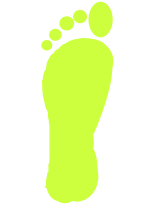Arched feet
| Classification according to ICD-10 | |
|---|---|
| M21.4 | Flat foot [Pes planus] (acquired) |
| Q66.5 | Pes planus congenitus |
| ICD-10 online (WHO version 2019) | |
If the longitudinal arch of the foot is flattened (the curvature of the sole of the foot on the inside of the foot in front of the Vorfußballen), this is referred to as fallen arches , respectively. If the skin of the sole of the foot under the longitudinal arch is fully loaded with a pronounced arched foot or if the contour of the inside of the foot is concave, the extreme form is a flat foot .
If, on the other hand, the rear foot is buckled in a valgus manner and the ankle is clearly protruding on the inside as a result, there is a buckled foot . Often, however, both are combined or not sufficiently differentiated, so that one speaks of a sagittarius .
Causes of the flat arch
As a rule, arched feet are caused by a weakness in the foot muscles that normally support the arch of the foot. This weakness is initially normal in young children, but should resolve itself over the course of a few years. But sedentary lifestyle, reinforced by the immobilization of the feet in the shoes , often prevents the necessary training stimulus on the foot muscles. This is why the muscle tension required for a stable arch of the foot has not yet developed in adolescents and adults . Feet weakness is almost always the reason for flat feet, only very rarely congenital malformations, which in case of doubt should be ruled out by a medical examination. When carrying heavy loads or standing frequently, the straps in the foot lengthen so that the foot touches down wider.
Consequences of the arches
Over the course of life , there is a risk of overuse pain in the weak foot muscles (e.g. plantar fasciopathy ), knee damage as a result of incorrect power transmission when walking and standing, the formation of a painful heel spur , intervertebral disc and back problems due to disturbed movement and insufficient shock absorption from the sunken arch of the foot.
Treatment of the arches foot
A causal treatment is to strengthen the muscles of the feet, ligaments and tendons. Muscle building is mainly stimulated by walking barefoot on a varied surface and by doing foot gymnastics . Ideal conditions for therapeutically effective barefoot walking have been created in numerous barefoot parks in recent years .
It is important to dose the workload so carefully at the beginning that no pain is felt. If walking barefoot hurts from the outset, you should first practice under the guidance of a physiotherapist . Since it is not always possible to go barefoot, it is advisable to wear shoes that allow the foot maximum mobility, such as B. moccasins , thong sandals , barefoot shoes and sports sandals.
Passive supportive insoles generally do not work against the underlying muscle weakness in adults. However, successes have already been recorded with under forty-year-olds. However, insoles can be important in order to passively correct the arched foot to such an extent that no further damage occurs to the feet, knees and back if you are on your feet for a long time or if you do sports.
A good support for building muscle in the foot can be footbed insoles that are filled with fluid. However, if there is an additional buckle foot, such insoles are not recommended because the buckling of the heel is increased by such insoles. Very good results are achieved with therapeutic plastic insoles made to measure (plaster foot model). These have a double function. On the one hand they support the foot and thus counteract pain, on the other hand they offer a guided, springy appearance and thus stimulate the foot muscles for training.
Babies and toddlers train their feet in the cradle. The toe game and the grasping movements serve the purpose of stabilizing the foot muscles. This is why you should not wear shoes or overly tight rompers or stockings. The baby's feet are still too weak to be able to counter the counter pressure. With children, however, the challenge of going barefoot and playing foot gymnastics should be the most important element of prevention and treatment, because building muscle can lead to improvement in them within months.
Insoles made of metal or cork leather that are too rigid, which were prescribed until the early 1980s, as well as the long-soled orthopedic insoles made of soft foam, which are predominantly prescribed today, can under certain circumstances be a disadvantage for children, as they additionally restrict the mobility of the feet and hinder muscle building . Insoles should only be used when gymnastics alone is no longer enough to build muscle. Modern, therapeutic insoles stimulate the foot muscles and thus contribute in a natural way to the fact that the muscles of the foot strengthen and maintain the bridge shape of the arches even under heavy loads.
In the past, orthopedic surgeons recommended sturdy, highly stable shoes in addition to rigid insoles. This therapy is out of date. Today, corrective or supportive therapeutic insoles and shoes with a cushioned sole are used depending on the severity of the foot decay. The “skate shoes” are often ideal because they also offer enough space in the toe area.
Sensorimotor or proprioceptive insoles have been increasingly prescribed for several years. To what extent they have an effect together with daily foot gymnastics or whether they have no effect like simple, orthopedic soft foam insoles, has not been sufficiently scientifically clarified.

